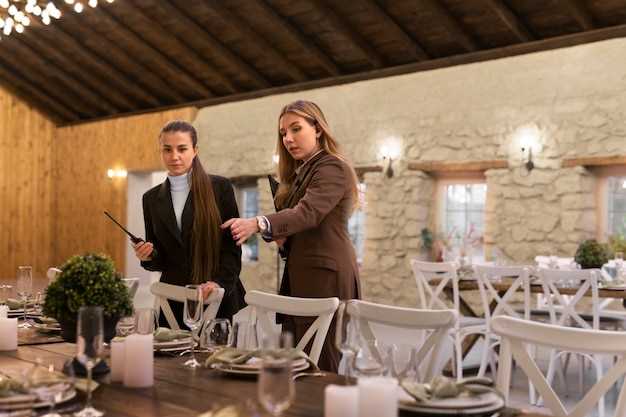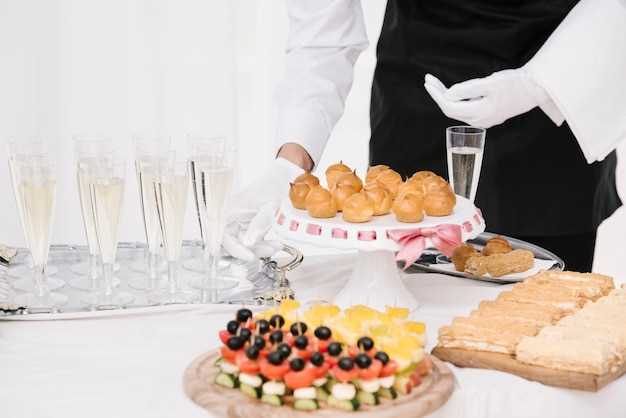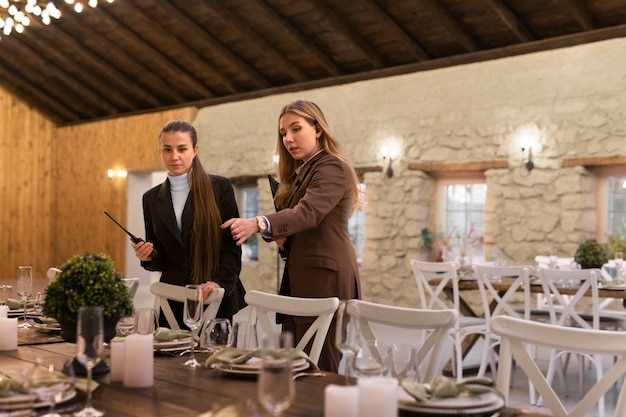Key Strategies for Planning a Successful Corporate Catering Event

Creating an unforgettable experience that leaves a lasting impression is an art form. The right choices can transform any gathering into something extraordinary. It requires careful thought and attention to detail. When there’s a synergy between ambiance, flavor, and presentation, magic happens. Guests feel valued and energized, setting the stage for meaningful connections.
Consider the diverse needs of attendees. Different preferences, dietary restrictions, and cultural backgrounds can greatly influence satisfaction. Engaging with the right providers is crucial. They should not only deliver high-quality dishes but also bring expertise in service. This seamless integration of food and atmosphere can elevate the entire experience.
Effective communication stands at the forefront of a well-executed arrangement. Sharing clear expectations with your vendor fosters a collaborative relationship. Building this foundation makes it easier to adapt to any last-minute changes. Similarly, having a well-defined timeline helps keep everyone on the same page. This blend of organization and flexibility can navigate even the most challenging of circumstances.
Incorporating personal touches can make all the difference. Whether it’s an innovative menu or stunning presentation, these elements resonate with the audience. Remember that every detail contributes to the overall impact. From the entrées to the final course, thoughtful choices create a cohesive narrative. In the end, every successful gathering hinges on how well the experience is crafted and delivered.
Understanding Your Catering Needs

Grasping the requirements for your food service can be a daunting task. Every gathering has its unique flavor and vibe. Identifying what works best is crucial. You want to create an enjoyable experience for everyone attending.
Consider the type of gathering you are hosting. Will it be formal or informal? Assess the preferences of your guests. Different cultures bring diverse tastes. Knowing your audience allows for better decisions.
Factor in the number of participants you’re expecting. A small group allows for a more intimate setting. On the other hand, large assemblies require meticulous planning.
Be mindful of dietary restrictions and allergies. It’s vital to cater to everyone’s needs. Collecting this information prior to the event can prevent potential issues. Not addressing these concerns may lead to unfortunate situations.
Determine your budget early in the conversation. Money plays a significant role in what options are available to you. By establishing parameters for expenses, you can streamline your choices and avoid overspending.
Finally, consider the theme and ambiance you wish to create. The culinary experience should align with the event’s overall atmosphere. Whether it’s a sleek corporate meeting or an engaging workshop, the right food selection can enhance your guests’ experience and make lasting impressions.
Define the Event’s Purpose and Audience
Understanding the goal of your gathering is crucial. It shapes everything from menu selection to venue design. Ask yourself what you aim to achieve. This clarity drives the overall planning process.
Consider who will attend the function. This impacts your choices and approach. Knowing your audience allows for tailored experiences. It’s about striking the right balance between formality and familiarity.
- Identify what you want participants to gain from the occasion.
- Think about the specific interests and preferences of your guests.
- Ensure that activities and food offerings align with their expectations.
For instance, a networking session may require a casual atmosphere with finger foods, while a formal presentation necessitates a more structured setup with seated dining options. All these elements contribute to the attendees’ overall experience and satisfaction.
Budgeting for Catering Services
Creating a financial framework is key to achieving your goals. A clear budget helps streamline the decision-making process. It enables you to allocate resources effectively. Every choice can impact your overall expenditure, so awareness is vital.
Start by estimating the number of attendees. This will provide a foundation for pricing. Consider your venue, menu preferences, and any extras required. Balancing these elements ensures you stay within financial limits.
Break down your costs into manageable sections. These can include food, beverages, service crew, and equipment rentals. Don’t overlook hidden charges that may arise later on. For example, some venues might add service fees that can significantly alter your budget.
When discussing options with providers, always ask for detailed quotes. Compare prices, but remember that the cheapest option might not be the best one. A higher-quality service could lead to a much better experience.
Additionally, having a buffer in your financial plan is wise. Unexpected expenses can emerge at any moment. Having flexibility allows for adjustments without stress. For instance, if a last-minute change arises, you won’t compromise on quality.
Lastly, document everything meticulously throughout the process. Track all expenses to get a complete picture of your spending. This practice will help you establish a stronger budget for future occasions. A comprehensive approach not only minimizes stress; it leads to a well-executed affair, ensuring everyone leaves satisfied.
Selecting Appropriate Menu Options
Choosing the right dishes can significantly impact the experience of attendees. Preferences, dietary restrictions, and meal timing all play crucial roles. Understanding the audience is vital to create a balanced selection. It’s essential to provide variety without overwhelming guests with too many choices.
Consider features like seasonal ingredients, cultural influences, and overall theme. A well-thought-out menu fosters engagement and satisfaction. Incorporating vegetarian, vegan, and gluten-free options ensures everyone’s needs are met, while also introducing exciting flavors to the table. The completion of this process requires careful attention to detail, ensuring that not only are the tastes diverse but also that the presentation is visually appealing and aligns with the overall atmosphere of the occasion.
Striking the right balance between sophistication and accessibility will enhance the overall enjoyment. Think about incorporating local specialties to connect with guests in a meaningful way. Seasonal offerings can add freshness, making each bite memorable. Ultimately, a thoughtfully curated menu can transform an ordinary gathering into an unforgettable culinary experience.
Considering Dietary Restrictions
Recognizing various dietary needs is crucial when organizing an occasion centered around food. Guests may follow specific diets for health, ethical, or religious reasons. It’s an aspect that shouldn’t be overlooked. Showing consideration here can enhance overall satisfaction and foster an inclusive atmosphere.
When planning the menu, think about including vegetarian and vegan options. Gluten-free selections can also cater to individuals with allergies or sensitivities. Provide clear labels on each dish for easy identification. This transparency allows attendees to make informed choices without feeling excluded.
Additionally, gather information about your guests’ preferences before finalizing the offerings. Surveys can be an effective way to gather insights into dietary restrictions. Consider key factors like allergies and food aversions to accommodate all attendees. By doing so, you create a welcoming environment where everyone feels valued and considered.
A thoughtful approach not only prevents potential issues but also showcases consideration and respect for diverse culinary practices.
Evaluating Service Styles
Choosing the right serving method can significantly influence the atmosphere and flow of your gathering. It impacts guest interactions and overall satisfaction. Several options exist, each offering unique benefits. Understanding these styles enhances the experience you aim to create.
Traditional buffet setups encourage guests to serve themselves. This style fosters mingling, allowing attendees to engage freely. In contrast, plated services provide a more formal environment, often resulting in a more structured event. Guests receive their meals directly at the table, which can enhance the dining experience.
Another option is a family-style service. Dishes are placed on the table, promoting sharing and conversation among guests. This method creates a communal ambiance, ideal for events where relationship-building is key. Additionally, it can streamline service while still providing an interactive experience. Understanding how each style aligns with your occasion’s objectives is crucial.
| Service Style | Description | Best For |
|---|---|---|
| Buffet | Guests serve themselves from a variety of dishes. | Casual gatherings, networking events |
| Plated | Meals are served individually at the table. | Formal occasions, business dinners |
| Family-Style | Dishes are shared among guests at the table. | Social events, community-focused gatherings |
When determining the most suitable approach, consider the event’s purpose, guest dynamics, and desired interaction levels. Each choice shapes the overall experience, so deliberation is key.
Executing a Flawless Catering Experience

Creating an impeccable service requires meticulous attention to every detail. It’s essential to understand the nuances of the occasion. From the selection of the menu to the timing of each course, every aspect matters. Ensuring a seamless flow can elevate the overall impact significantly. Having a well-structured plan in place is critical for achieving this goal.
First, it is vital to establish clear communication with all involved parties. Assign roles and responsibilities to staff members to avoid confusion. Regular check-ins during the event help maintain clarity. A central point of contact can streamline decision-making when issues arise.
Moreover, the atmosphere can change the mood entirely. Ambiance plays a crucial role in shaping guests’ experiences. Comfortable seating and appropriate lighting contribute to an inviting environment. Additionally, background music can enhance enjoyment without becoming intrusive.
Attention to guest preferences is an integral part of the process. Offering diverse menu options respects dietary restrictions and personal tastes. Having a selection of items allows individuals to choose according to their preferences. Keeping this in mind demonstrates respect for attendees, which can foster a positive environment.
While catering can seem daunting, efficient execution relies heavily on preparation. Prior to the big day, conducting a thorough walk-through ensures everyone knows what to expect. This rehearsal can reveal potential issues that might be easily overlooked. Taking the time to plan the logistics in advance will pay off tremendously during the actual event.
Ultimately, a flawless service hinges on adaptability and problem-solving skills. Unexpected situations can occur, but being prepared for such instances minimizes panic. Training staff to handle challenges gracefully is instrumental. Remember, the event’s ambiance largely relies on how well you manage the unforeseen.
Coordinating with Catering Providers
Establishing a smooth collaboration with food service professionals is crucial. Clear communication can make all the difference. It’s not just about the menu; it’s about understanding expectations. Both parties should be on the same page to achieve desired outcomes.
Start with your objectives. What atmosphere do you want to create? Discuss these ideas openly. Share your vision and seek feedback. You may discover new concepts that enhance your approach. Providing detailed information about your gathering can lead to better food choices.
Timelines are vital in this process. Set milestones for decision-making and check-ins. Be proactive in addressing potential issues. Emphasizing flexibility can help navigate last-minute changes effectively.
Additionally, keep dietary restrictions at the forefront. Identifying guests’ needs ensures everyone is accommodated. Provide this information well in advance. This allows the culinary team to craft a well-rounded menu that delights all attendees. Consideration for allergies and preferences speaks volumes about your attention to detail.
Finally, don’t underestimate the significance of a site visit. A walkthrough allows the caterers to understand the venue’s layout and logistics. This collaboration enhances service flow, ensuring everything runs seamlessly. When both parties work together, the results are bound to exceed expectations.
Logistics and Timing Management
Organizing an engaging gathering hinges on several key factors that can make or break the experience. Attention to detail in logistics can streamline the entire operation. Timing is equally critical and can affect guest satisfaction significantly. Every component requires careful consideration and coordination.
Begin by outlining a clear timeline. This includes the moment you decide on a venue to the final cleanup. Identify important milestones and deadlines. Make a checklist that will serve as a reference.
- Confirm venue availability well in advance.
- Schedule deliveries early to avoid last-minute complications.
- Allocate enough time for setup and breakdown.
- Designate roles for team members, ensuring everyone knows their tasks.
Moreover, think about the flow of activities. Smooth transitions between different segments enhance the overall atmosphere. When guests feel taken care of, it reflects positively on the occasion.
- Plan the arrival times for attendees.
- Use a timeline for presentations or speeches.
- Ensure catering staff is ready to serve at peak moments.
The interconnection between logistics and timing can create a memorable experience, but only if meticulously executed. Consistent communication among vendors, the team, and participants keeps everyone on the same page. Being proactive in addressing potential hiccups is essential for maintaining a seamless flow. Ultimately, a well-structured approach fosters an enjoyable atmosphere, leaving a lasting impression on your audience.
Setting Up Your Venue
Creating the right atmosphere is crucial for any gathering. The choice of location significantly impacts the overall experience. It involves careful consideration of layout, accessibility, and aesthetic appeal. An inviting space encourages interaction and engagement among guests. Every detail matters when cultivating a vibrant environment.
Begin by evaluating the dimensions and configuration of your chosen area. Determine how much space is needed for dining, mingling, and any activities. Comfort is paramount; ensure ample room for all attendees to move freely. Proper seating arrangements can enhance communication and foster connections.
Lighting plays a vital role in setting the mood. Natural light can create a warm and welcoming feel, while dimmer settings may lend a more intimate vibe. Consider using decorative lighting elements to enhance the overall aesthetic. Rich colors, interesting textures, and complementary decor can shift the atmosphere in a desired direction.
Sound is another factor that shouldn’t be overlooked. Background music can elevate the event, but it should never overwhelm conversations. If speeches or presentations are included, ensure the acoustics are optimized for clarity. Pay attention to the placement of speakers and any necessary audio-visual equipment.
Lastly, don’t forget about logistics. Ensure that essential facilities, such as restrooms and parking, are conveniently located. Accessibility for all guests enhances overall enjoyment. A well-organized space allows everyone to focus on the experience rather than logistical challenges.
Video:

How to Create an Event Planning Checklist
How to Create an Event Planning Checklist by International Institute of Event Management 127,170 views 6 years ago 2 minutes, 1 second
Q&A:
What are the first steps I should take when planning a corporate catering event?
The initial steps in planning a corporate catering event include defining the purpose and objectives of the event, setting a budget, and identifying your target audience. Once these factors are established, consider the venue’s size and atmosphere, and whether it aligns with your event’s theme. From there, you can begin researching catering options, deciding on the menu, and scheduling logistics such as timing and service requirements. It’s also beneficial to create a timeline to ensure all details are covered as the event date approaches.
How do I choose the right catering service for my event?
Selecting the right catering service is crucial. Start by gathering recommendations from colleagues or event planning resources. Research potential caterers by reviewing their online presence, checking for reviews, and asking for references. Schedule tastings with a few shortlisted caterers to evaluate their food quality and presentation. Additionally, consider their flexibility with menu customization to accommodate dietary restrictions or preferences, and ensure they have experience with corporate events to understand your specific needs. Availability on your event date and their ability to handle the logistics, including staff and equipment, should also be part of your decision-making process.
What types of cuisine are generally preferred for corporate events?
The type of cuisine for a corporate event often depends on the nature of the event and the preferences of the attendees. Generally, a mix of American, Mediterranean, Asian, and Italian cuisines tends to be well-received, as they offer a variety of flavors and options. It’s also advisable to include vegetarian, vegan, and gluten-free options to cater to different dietary needs. Understanding the cultural backgrounds of your attendees can further guide your menu choices, ensuring everyone feels included. When in doubt, consider conducting a simple survey before the event to gauge preferences.
How can I ensure the catering setup runs smoothly during the event?
To ensure a smooth catering setup, it’s important to have a detailed plan in place. First, communicate clearly with your caterer about the event timeline and layout. Conduct a walk-through of the venue with the catering team prior to the event, if possible. On the day of the event, arrive early to oversee the setup, ensuring the proper equipment and supplies are in place. Designate specific areas for food service, seating, and beverage stations to avoid congestion. Having a point person from your team to liaise with the caterers can also facilitate effective communication during the event. Lastly, allow flexibility in your schedule to adapt to any unexpected situations.
What are some tips for managing dietary restrictions at a corporate catering event?
Managing dietary restrictions effectively starts with gathering information from your attendees well in advance. Consider sending out RSVP forms that include questions about any food allergies or dietary preferences. Once you have this information, work closely with your catering service to create a diverse menu that accommodates various needs, such as vegetarian, vegan, gluten-free, and nut-free options. Clearly label all food items during the event to avoid confusion, and have a staff member available to assist guests with inquiries about the menu as needed. Staying proactive will help ensure that all guests can enjoy the meal without concerns about their dietary requirements.
What are the key factors to consider when choosing a catering service for a corporate event?
When choosing a catering service for a corporate event, several key factors should be considered. Firstly, determine the type of event and its atmosphere, whether it’s formal, casual, or a mix. This will guide your choice in cuisine and style. Secondly, assess the catering company’s experience with corporate events; look for testimonials and references, especially for similar company sizes and styles. Additionally, consider the menu options they provide—ensure they can accommodate dietary restrictions and preferences of your attendees. Thirdly, check their availability and responsiveness during the planning phase, as clear communication is critical. Lastly, compare budgets and ensure the service offers good value for the quality provided, including additional elements like staff, equipment, and logistics support.
How can I ensure that the food served at my corporate catering event aligns with the event theme?
To ensure that the food at your corporate catering event aligns with the event theme, start by defining the theme clearly. Is it a formal black-tie dinner, a casual picnic, or a cultural celebration? Once you have your theme established, communicate your vision to the catering company. You can collaborate on a menu that reflects the theme through ingredient choices, presentation styles, and service methods. For example, if your event is a summer barbecue, consider grilled items, fresh salads, and seasonal fruits. Additionally, aesthetically themed platters, custom decorations, and suitable beverage pairings can enhance the overall feel. Lastly, taste testing is crucial—host a tasting session where you can sample menu options that match the theme; this also allows you to make adjustments based on feedback from stakeholders involved in planning the event.


